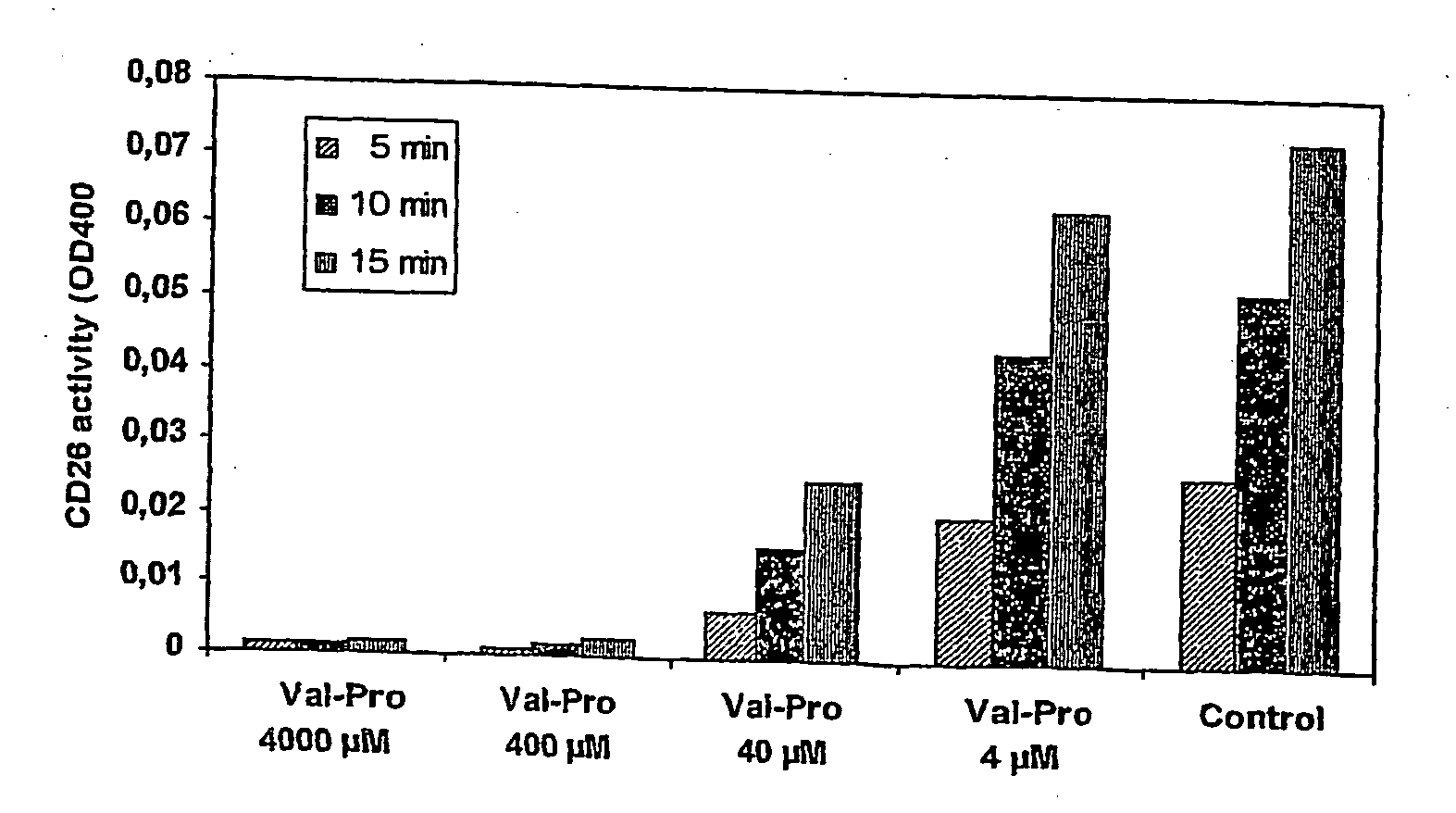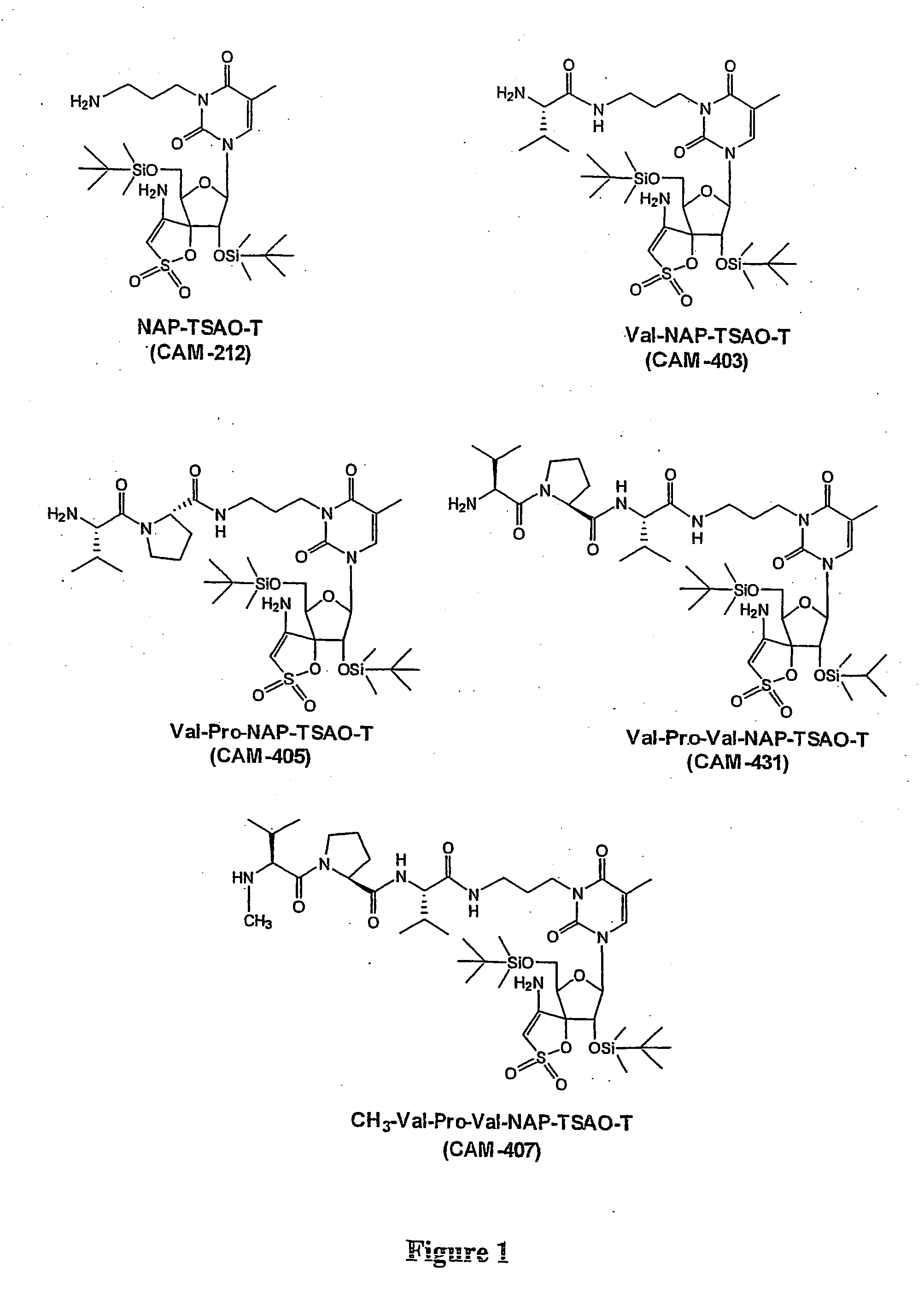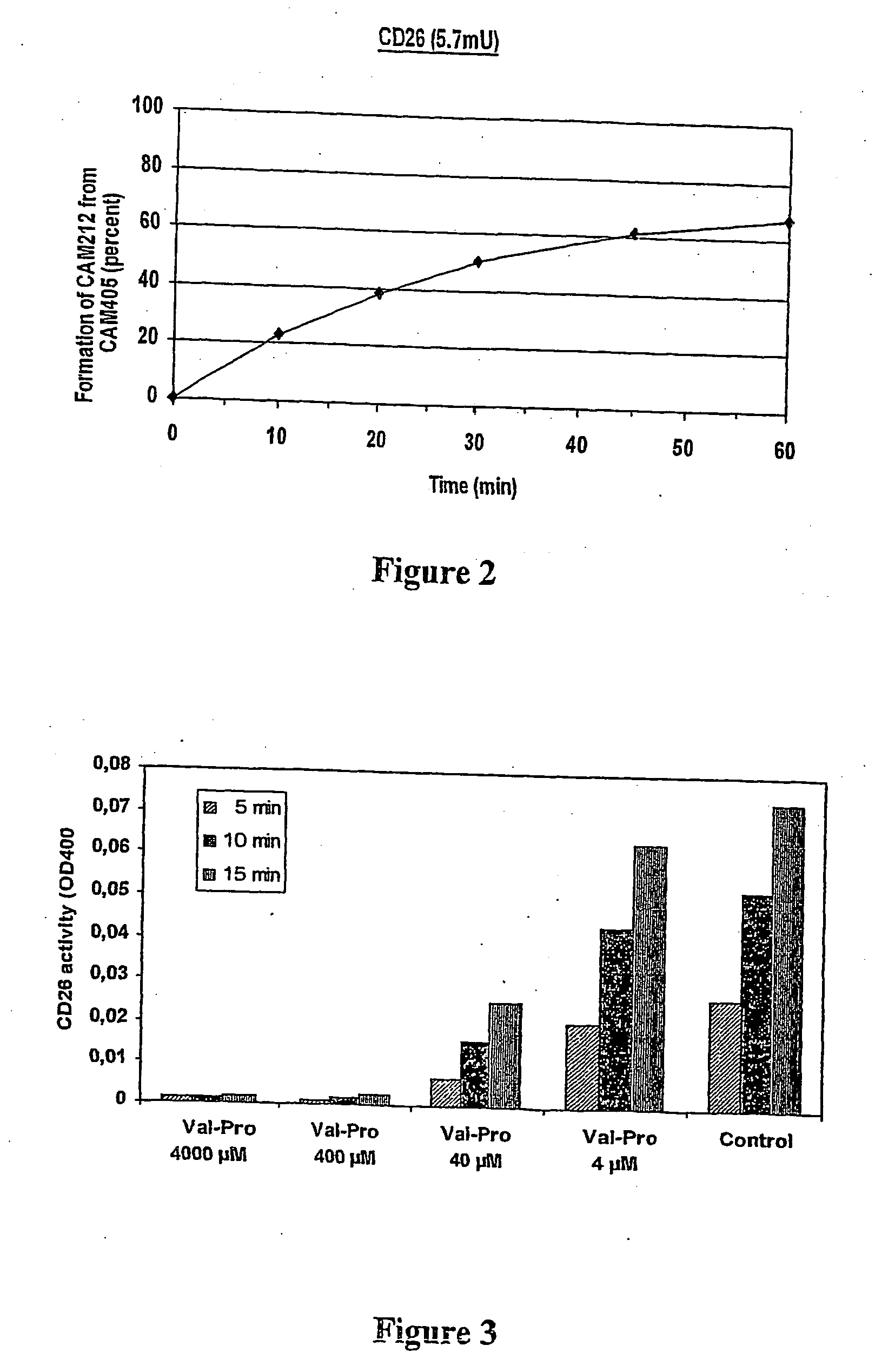Prodrugs Cleavable by Cd26
a technology of cd26 and prodrugs, applied in the direction of drug compositions, immunological disorders, metabolism disorders, etc., can solve the problems of unfavorable physicochemical and biopharmaceutical unsatisfactory physicochemical properties of many existing drug molecules already on the market, and unrealized medical advances
- Summary
- Abstract
- Description
- Claims
- Application Information
AI Technical Summary
Benefits of technology
Problems solved by technology
Method used
Image
Examples
example 1
Conversion of Val-Pro-NAP-TSAO and Val-Pro-Val-NAP-TSAO to the Parent Compounds NAP-TSAO and Val-NAP-TSAO by Purified CD26
[0161] The lipophylic N3-aminopropyl-substituted TSAO-m3T nucleoside derivative NAP-TSAO (CAM-212) has been chemically linked to the dipeptide Val-Pro and the tripeptide Val-Pro-Val through the free carboxylic acid end of the di / tripeptide resulting in CAM-405 (Val-Pro-NAP-TSAO) and CAM-431 (Val-Pro-Val-NAP-TSAO) (FIG. 1). To reveal whether CD26 recognizes such synthetic di / tripeptide derivatives of lipophylic nucleoside analogues as a substrate, 50 μM CAM-405 or CAM-431 was exposed to 5.7 mUnits of purified CD26, and the conversion of CAM-405 or CAM-431 to respectively CAM-212 or CAM-403 (Val-NAP-TSAO) was recorded in function of incubation time by HPLC analysis. The identity of the formed CAM-212 product was revealed by HPLC analysis using the reference parent compound as control, and by mass spectrometry. We found that CD26 efficiently removed the dipeptide V...
example 2
Conversion of Tetrapeptide-NAP-TSAO Compounds to the Parent Compound NAP-TSAO by Purified Human CD26
[0163] The conversion rate in function of time is given in Table 2 for tetrapeptide NAP-TSAO compounds where the tetrapeptide consists of: Val-Pro-Val-Pro [SEQ ID no:6] (CAM 467), Val-Ala-Val-Pro [SEQ ID no:7] (CAM 473) or Lys-Pro-Asp-Pro [SEQ ID no:8] (CAM 477). It is clear that the conversion rate to the parent NAP-TSAO of CAM 473 occurs faster than with the Val-Ala-NAP-TSAO (CAM 424). Only traces of dipeptide prodrug (CAM 405) is seen as intermediate in the conversion of the tetrapeptide CAM 473 to NAP-TSAO. Also Val-Pro-Val-Pro-NAP-TSAO [SEQ ID NO:6] is quickly converted to NAP-TSAO. In contrast, CAM 477 conversion to NAP-TSAO clearly occurs in two steps, the fast initial step forming CAM 435 (Asp-Pro-NAP-TSAO) followed by the slow second step forming eventually NAP-TSAO (CAM 212) from Asp-Pro-NAP-TSAO.
TABLE 2Tetrapeptide prodrugs: conversion rate to parentcompound by purified ...
example 3
Conversion of Val-Pro-NAP-TSAO and Val-Pro-Val-NAP-TSAO to the Parent Compounds NAP-TSAO and Val-NAP-TSAO by Human and Bovine Serum
[0164] Human and bovine serum were incubated for 3 hr, 6 hr and / or 24 hr at 37° C. in the presence of 50 μM CAM-405. The sera were diluted in PBS at a final concentration of 0.5, 1, 2.5 or 5%. Both human (HS) and bovine (BS) serum efficiently converted CAM-405 to CAM-212. The longer the incubation time, and the higher the serum concentration used, the faster the conversion of CAM-405 to CAM-212 occurred (FIG. 4). As also noted for CD26, HS- and BS-catalysed reaction slowed down in function of time, and was not linearly proportional with serum concentration (FIG. 4). These findings provide again evidence for a pronounced feed-back inhibition of dipeptidyl-peptidase activity in human and bovine serum by the released Val-Pro dipeptide. HS was more efficient in converting CAM-405 to CAM-212 than BS (FIG. 4). Since 1% HS is able to hydrolyse ˜20% of 50 μM CA...
PUM
| Property | Measurement | Unit |
|---|---|---|
| diameter | aaaaa | aaaaa |
| retention time | aaaaa | aaaaa |
| structure | aaaaa | aaaaa |
Abstract
Description
Claims
Application Information
 Login to View More
Login to View More - R&D
- Intellectual Property
- Life Sciences
- Materials
- Tech Scout
- Unparalleled Data Quality
- Higher Quality Content
- 60% Fewer Hallucinations
Browse by: Latest US Patents, China's latest patents, Technical Efficacy Thesaurus, Application Domain, Technology Topic, Popular Technical Reports.
© 2025 PatSnap. All rights reserved.Legal|Privacy policy|Modern Slavery Act Transparency Statement|Sitemap|About US| Contact US: help@patsnap.com



